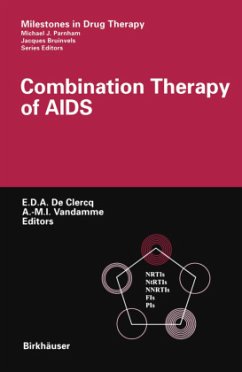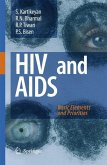This book is the first to tackle, in a single treatise, a subject that has recently become a discipline in its own right, that of the combination antiretroviral therapy of AIDS. It is aimed at an audience of clinicians, researchers, public health workers, specialists or non-specialists in AIDS and particularly those who want to know how to optimally approach the treatment of AIDS. Combination drug treatment of AIDS is focussed from different angles and perspectives, historical, basic, economic, theoretical, virological, immunological, clinical and practical reasons for therapy failures are examined and strategies to prevent or overcome failing therapies are formulated. This book fills a gap in the current literature on clinical therapeutics. It should be particularly informative to those who want and need to know more about the current treatment of AIDS, with its successes and failures, but also with lessons and guidelines to affront these failures.
HIV infection has been a greater challenge to current medicine than any other viral disease ofmodem times. HIV leads to a persistent infection and the virus has an immense genetic flexibility under selective pressure. During its replica tive cycle in patients, HIV accumulates mutations at such a high rate that the selective pressure inflicted on the immune system, or generated by antiviral drugs rapidly triggers the appearance of escape mutants. Currently available drugs, when used singly, are not capable of suppressing virus replication in patients to such a level that the generation of mutations, from which a variant resistant to immune attack or antiviral drugs can be selected, is prevented. This is the main reason why combination therapy, usually of three drugs, has become the standard procedure for the treatment ofAIDS. It is obvious that virus eradication will not readily be achievable, so that drugs have to be taken for a prolonged time or even lifelong so as to keep the viral load as low as possible. Whether the currently used drug combinations will be able to control virus replication in a particular patient for such a pro longed period of time depends on many factors, most of which are addressed in the different chapters of this book. The aim of antiviral drug combination therapy for AIDS is ultimately to restore full function of the immune system.
HIV infection has been a greater challenge to current medicine than any other viral disease ofmodem times. HIV leads to a persistent infection and the virus has an immense genetic flexibility under selective pressure. During its replica tive cycle in patients, HIV accumulates mutations at such a high rate that the selective pressure inflicted on the immune system, or generated by antiviral drugs rapidly triggers the appearance of escape mutants. Currently available drugs, when used singly, are not capable of suppressing virus replication in patients to such a level that the generation of mutations, from which a variant resistant to immune attack or antiviral drugs can be selected, is prevented. This is the main reason why combination therapy, usually of three drugs, has become the standard procedure for the treatment ofAIDS. It is obvious that virus eradication will not readily be achievable, so that drugs have to be taken for a prolonged time or even lifelong so as to keep the viral load as low as possible. Whether the currently used drug combinations will be able to control virus replication in a particular patient for such a pro longed period of time depends on many factors, most of which are addressed in the different chapters of this book. The aim of antiviral drug combination therapy for AIDS is ultimately to restore full function of the immune system.








